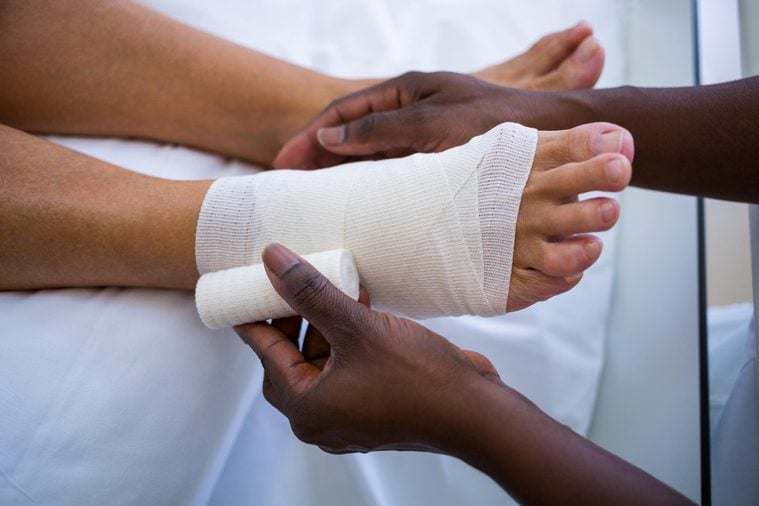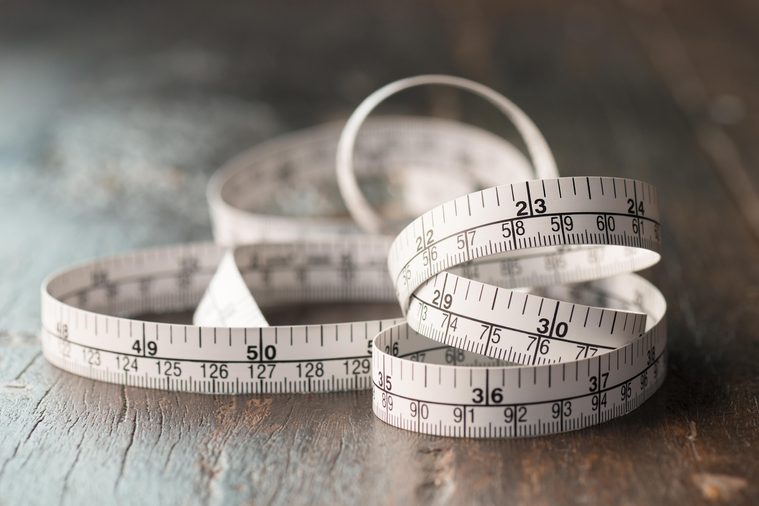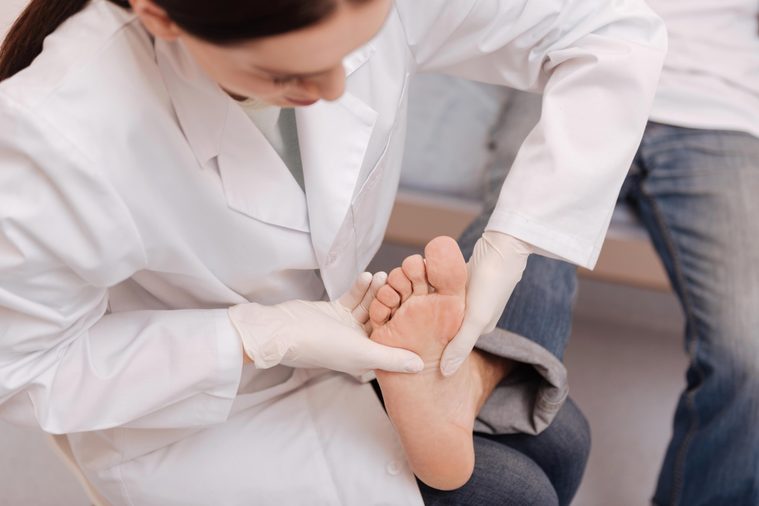SDI Productions/Getty Images
Talking about feet
From ingrown toenails and bunions to sprains, strains and broken bones, there are lots of reasons you might visit a podiatrist. Your foot doctor will no doubt give you all the information you need to help with your condition, but they can cover only so much ground during an office visit.
So there’s so much more they’d like you to know about avoiding foot pain, preventing infections and keeping your feet and toenails healthy.
Monkey Business Images/Shutterstock
1. When you go into a shoe store, your salesperson should measure your feet
Have your feet professionally measured every time you shop for shoes. Natural aging and changes in your health can cause the size of your feet to change. Measure both feet—late in the day—and shop for the larger foot.—Lori Weisenfeld, DPM, a sports podiatrist in New York City
5 Warning Signs Your Shoes Are Ruining Your Feet
2. You love walking barefoot
If you transitioned to working from home in recent years, walking barefoot around the house all day could be leading to things like plantar fasciitis, Achilles tendinitis and other types of tendinitis.—Jane Andersen, DPM, a podiatrist at Chapel Hill Foot & Ankle Specialists in Chapel Hill, North Carolina.
Is Walking Barefoot Bad For Your Feet?
3. You don’t have to spend big bucks on foot therapies
This DIY foot soak will help clear up foot and toenail fungus, brighten nails and soften skin: Combine 1/2 cup apple cider vinegar, 2 cups warm water,= and 2 tablespoons baking soda. Soak for 20 minutes a few times a week.—Jacqueline Sutera, DPM, board certified doctor of podiatric medicine and surgery in New York City
krit mahawat/Shutterstock
4. Your feet don’t need to smell
You use antiperspirant on your armpits to keep them from getting stinky, right? Well, the same stuff works on your feet. Try a spray and alternate your shoes so they have a chance to dry completely. Wear socks, as well, otherwise, the sweat will promote the growth of bacteria that stay in your shoes.—Dr. Andersen
10 Reasons for Smelly Feet—and 10 Solutions
6. Bring your own pedicure utensils to the salon
Why? Because bacteria and fungus can move easily from one person to the next if the salon doesn’t use proper sterilization techniques.—Dr. Weisenfeld
vystekimages/Shutterstock
8. Buy shoes at a specialty running store, even if you just walk for exercise
A well-trained staff at an athletic shoe store will help you get the right shoe for your exercise of choice. They will typically analyze your foot and gait, offering the best sneakers to fit your needs.—Dr. Sutera
wavebreakmedia/Shutterstock
9. I’ve seen all sorts of things, including people who have shot their feet
You really shouldn’t clean your loaded gun after you’ve had a couple of beers. Another dumb move: Mowing the lawn in flip-flops. The first weekend of every spring, doctors see a lot of injuries.—Marlene Reid, DPM, podiatric physician and surgeon and owner of Family Podiatry Center in Naperville, Illinois
I’m a Hand Surgeon—Here Are 6 Things I’ll Never Do
Fecundap stock/Shutterstock
10. If you have dry, cracked feet, try this moisturizer
AmLactin is just an over-the-counter lotion, but it’s like a miracle. Put it on a couple of times a week, and the calluses will just slough off.—Dr. Sutera
11. Sometimes if a bunion is really bad, a patient will ask me to amputate her second toe
That doesn’t mean podiatrists will do it, though, because it won’t fix the problem. It’s best to get bunions taken care of at a young age. If you wait until they get really bad, they’re much harder to fix.—Dr. Reid
The 5 Types of Bunions: What Podiatrists Need You to Know
KatarzynaBialasiewicz/Getty Images
12. Not all bunions need surgery
A candidate for bunion surgery is someone who has difficulty wearing shoes and foot pain is starting to slow them down physically. Someone who says, for example, “I used to love going for long walks and now I can’t because my feet hurt.” People with mild to moderate bunions often can get relief from wider shoes, massage, stretching, orthotics and some padding.—Dr. Sutera
14. Coconut oil is something of a cure-all
Coconut oil is known to have anti-fungal properties. Use it to moisturize cuticles, as well as skin—especially cracked and calloused areas.—Dr. Sutera
noicherrybeans/Shutterstock
16. Fit your shoe to your longest toe
That might not be your great toe—a lot of people’s second toe is longer.—Dr. Weisenfeld
ahirao_photo/Getty Images
17. Your athletic shoes shouldn’t be the same size as your regular shoes
There should be one thumb’s width between the end of your longest toe and the tip of the shoe.—Dr. Weisenfeld
19. There’s no such thing as a “minor” foot infection
An infection in your foot that’s left unchecked can lead to a bone infection. Even a seemingly minor infection from a pedicure can become much more serious if it travels to the bone. Address these early and consistently.—Dr. Andersen
Image Source/Getty Images
23. If you use a pumice stone, file in one direction
Don’t scrub back and forth, like you would a dirty pot or pan—this roughs up the skin even more. You can also opt for a battery-powered foot file, which rotates in a circular motion. But be careful: Use lightly once a week, instead of going at it deeply once a month.—Dr. Sutera
25. Socks that are too small can cause blisters
Yes, just like a shoe can. Go with what feels comfortable.—Dr. Andersen
27. The best socks are not 100% cotton
Look for materials that promise to wick moisture away.—Dr. Andersen
YAKOBCHUK VIACHESLAV/Shutterstock
28. A lot of women are embarrassed to show me their feet
Many women say they feel as if they’re going to a gynecologist when they have to take off their shoes!—Dr. Reid
















































